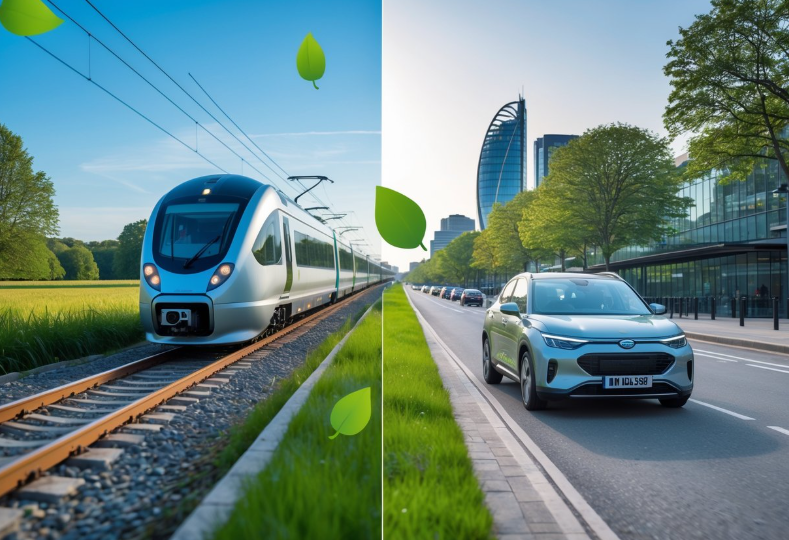When you’re heading to Heathrow Airport (LHR), it’s pretty common to wonder: is the train or a ride-share car actually better for the climate? Choosing the train instead of a car or taxi cuts carbon emissions by up to 80% for the same journey.
This makes trains one of the cleanest options for getting to the airport compared to eco-friendly Heathrow transfers, driving alone or booking a ride-share.
Research shows that trains emit about 35 grams of carbon dioxide per kilometre per passenger. Cars and ride-shares can emit over 170 grams for the same distance.
Travelling by train uses less energy per person and helps reduce air pollution in busy cities like London. For detailed numbers and some practical tips, stick around—there’s a clear breakdown coming up and it’s honestly worth a look if you care about your impact.
For more facts, check out this carbon footprint of different transport methods comparison and see why public transport stands out.
Understanding Carbon Footprint Calculations
Calculating carbon footprints for travel by train or ride-share involves specific methods and rules. You’ve got to look at how emissions are measured, what units are used, and how these numbers are reported.
Key Methodology & Emissions Factors
Travel emissions are measured by the amount of carbon dioxide equivalent (CO2e) released per kilometre, per passenger. For trains, this often uses average emissions data based on the type of train, how full it is, and the source of electricity if the train is electric.
Diesel and electric trains have different emission profiles. Major rail companies sometimes publish their own calculation methods, so you can estimate your carbon impact per journey if you really want to geek out.
For ride-share cars, emissions depend on the vehicle’s fuel type, efficiency, and how many people are sharing the ride. Car emissions are usually higher per passenger unless the car is full.
The carbon footprint for each mode is calculated by multiplying the journey distance by the right emissions factor for that vehicle. Nothing too wild there, but the devil’s in the details.
Units and Reporting Standards
The most common unit for reporting travel emissions is grams of CO2e per passenger kilometre (gCO2e/pkm). This makes it easy to compare trains, cars, and other forms of transport side by side.
Some organisations might use kilograms or tonnes for longer trips, but the goal is always to standardise data so users can make fair choices. Travel calculators and worksheets, like those in international guides, use these units too.
For accuracy, it’s important to note how each company reports emissions, as different methods or regional quirks might change results. Clear units and reporting are key for understanding and comparing the carbon footprints of different journeys.
Comparing Train and Ride-Share Emissions
Choosing between a train or ride-share to London Heathrow (LHR) can have a big impact on carbon emissions. Emissions depend on factors like how many people share a vehicle, what fuel is used, and how efficient each transport type is.
Ride-Share vs. Rail CO₂ per Passenger
On average, trains produce much less CO₂ per passenger than ride-shares or private cars. A typical diesel or electric train in the UK emits about 35 to 50 grams of CO₂ per passenger-kilometre.
In contrast, a ride-share or private car often emits around 120 to 170 grams per passenger-kilometre when there’s just one or two people in the car.
This difference is even more significant on busy rail routes, where high occupancy rates help spread out emissions. Switching to the train can lower emissions significantly, sometimes by more than half, compared with using a car or ride-share service.
Vehicle Occupancy Rates
The more people in a vehicle, the lower the emissions per passenger. UK trains usually carry hundreds of passengers at once, so the emissions for each person are much lower.
For ride-shares, the average occupancy is usually 1.5 people per ride, with some cars carrying just the driver. Higher car occupancy can reduce per-person emissions, but it rarely matches the efficiency of trains with nearly full carriages.
In most real-world cases, low car occupancy keeps ride-share emissions well above train emissions, especially for popular routes to or from major airports such as Heathrow.
Fuel Types and Efficiency
Fuel source has a big impact on emissions. Modern trains in the UK are often electric or use a mix of diesel and electricity.
Electric trains powered by low-carbon electricity from the grid have some of the lowest emissions. Ride-share vehicles are mostly petrol or diesel.
While there are some hybrid and electric ride-share options, these are still a small part of the total. Even efficient petrol or diesel cars release more CO₂ per passenger unless full.
Train operators benefit from investment in cleaner energy, making trains a cleaner choice for most journeys. Tools like carbon calculators help compare these factors for any UK journey (Train vs Car Comparison).
Peak and Off-Peak Travel Impacts
Travel emissions when going to London Heathrow (LHR) can shift based on when someone travels. The number of passengers, train schedules, and ride-share use at different times all affect how much carbon is produced.
Off-Peak vs. Peak Impact
Peak hours usually mean packed trains, longer ride-share waits, and busy roads. More people on a train during rush hour can make each person’s share of emissions lower.
Trains at peak times carry many passengers per trip, making them a more efficient choice for cutting per-person emissions. In contrast, off-peak times have fewer travellers.
Trains might run nearly empty, so the emissions per passenger go up. For ride-shares, off-peak trips deal with less traffic, leading to less time idling and lower emissions per ride.
Traffic congestion during peak times can cause ride-share vehicles to burn more fuel as they spend extra time stuck on the road. Choosing public transport during busy periods often results in smaller carbon footprints compared to ride-shares, especially for journeys into and out of central London.
Schedule Variability and Emissions
Train and ride-share schedules are not consistent all day. During peak periods, rail services increase frequency to handle crowds.
At off-peak times, the number of trains drops, sometimes leading to longer waits or choosing less direct routes. For ride-shares, fewer bookings off-peak may make cars drive further between pickups.
Empty running (travelling without a passenger) uses extra fuel and adds to total emissions. The table below highlights how timing affects travel choices:
| Time of Day | Train Load | Ride-Share Wait | Emissions per Passenger
|
|---|---|---|---|
| Peak | High | Long | Low (train), High (car) |
| Off-Peak | Low | Short | High (train), Lower (car) |
Adjusting travel to use trains during peak times, or planning ride-shares for off-peak hours, can change the carbon impact. For more details on differences in emissions by mode and time, see the Journey emissions comparisons: methodology and guidance page.
Factors Affecting Carbon Output
The carbon footprint of a journey between London Heathrow Airport (LHR) and the city can change a lot depending on the route taken and the areas travelled through. Key variables like distance, traffic, and energy sources play a big role in how much carbon is released.
Route Length and Directness
The total length and directness of a route are vital when comparing carbon emissions. Train routes often follow the most efficient path between destinations.
Trains can also carry many passengers at once, spreading out emissions per person. For example, on longer direct trips, a train might emit as little as 6 grams of CO2e per passenger-kilometre if powered by electricity.
In contrast, ride-share journeys may take longer routes due to road layouts, diversions, or traffic. Petrol and diesel cars release more CO2 per kilometre, partly because they use more fuel for every detour or stop-start.
Car journeys also include what’s known as the “uplift factor,” a correction of around 31.5% added to emissions to reflect real-world conditions like idling and less-than-perfect driving methodology explanation.
Urban vs. Suburban Journeys
Journeys through urban areas often involve more stopping, starting, and time spent in traffic jams. This raises carbon output for car and ride-share options, as engines run less efficiently.
Urban rail services can be affected, but electric trains lose less efficiency in slow traffic. They keep a steady pace and can move many people at once, keeping emissions per person low.
Suburban or cross-country stretches tend to be faster and less congested. Ride-share vehicles may perform better here.
However, unless there is carpooling, the emissions per person often stay higher than for a well-occupied train. Types of train service matter too; national rail lines running on diesel may release more CO2, while electrified lines keep emissions low as long as the energy comes from clean sources emissions comparison.
Reducing Your Carbon Footprint When Travelling to LHR
Choosing how to reach Heathrow Airport (LHR) can affect your personal impact on the environment. Actions both big and small make a real difference to the amount of CO₂ released when travelling.
Small Steps Travellers Can Take
Packing lighter makes transport more efficient, as lighter bags require less fuel to move. Reusable water bottles and shopping bags reduce single-use plastic waste during the journey.
Using digital tickets instead of printed ones also helps cut down on paper use. If possible, booking in advance can secure a seat on trains with higher occupancy rates, which means less emissions per person.
Eating locally sourced food before or during your journey reduces emissions tied to the transport of food over long distances. Some train providers even offer carbon calculators to see how personal choices add up; Greater Anglia offers a carbon calculator comparing car and train travel.
Choosing Greener Options
Ever thought about ditching the car and hopping on a train? In the UK, trains emit far less CO₂ per passenger than most cars or planes. For example, a 500 km train trip might only put out about 4.4 kg of CO₂ per passenger.
If you do need to ride-share, going for an electric or hybrid vehicle is definitely a step in the right direction. Try to stick to direct routes without unnecessary detours or stops—wasted miles just burn more fuel.
Some rail operators even use renewable energy, so it’s worth checking. Walking or cycling for the first or last bit of your journey can help too, as shown in research comparing transport methods. Every little greener tweak, even just for part of a trip, really does add up over time.
Frequently Asked Questions
Carbon emissions from different types of transport aren’t all created equal. The method, fuel, distance, and number of passengers can change the numbers a lot. If you’re heading from Heathrow (LHR), your choice between train or ride-share will shape your CO₂ footprint for the trip.
How do carbon emissions compare between trains and ride-sharing services per kilometre travelled?
Trains usually come out ahead, producing less carbon dioxide per kilometre travelled than ride-sharing vehicles. For instance, electric trains emit about 0.03549 kg CO2 per passenger per kilometre. An average petrol car? That’s closer to 0.17431 kg CO2 per passenger per kilometre. Unless you’re carpooling with a full vehicle, ride-shares aren’t much better than regular cars.
What is the average CO2 emission for an individual using ride-share services versus taking the train?
On average, if you’re using a ride-share like a taxi, you’ll create more CO2 than if you’d taken the train. Petrol-powered cars can emit about five times more per passenger per kilometre than electric trains. Of course, if the train or car is nearly empty, those numbers can shift a bit.
Which mode of transport adds more to one’s carbon footprint: trains or ride-sharing vehicles?
Generally, ride-sharing vehicles add more to your carbon footprint than trains. Most ride-shares still use petrol or diesel, while plenty of UK trains run on electricity. If you’re on a busy route with lots of passengers, trains really shine for low emissions.
How can one calculate the carbon footprint of different transportation options?
If you want to crunch the numbers, multiply the distance by the CO2 emission factor for each mode. Sharing a ride? Divide total emissions among all passengers. There are handy tools for this, like the ScotRail Carbon Calculator or EcoTree’s Train CO2 calculator.
Are trains a more sustainable choice for reducing environmental impact compared to ride-shares?
Trains—especially electric ones—are generally seen as a more sustainable pick. According to Green Travel Data, rail travel uses less carbon than cars on about 85% of station-to-station routes. So, if you’re aiming to shrink your carbon footprint, trains are a solid bet.
What factors should be considered when comparing the eco-friendliness of trains versus ride-sharing options?
When you’re weighing eco-friendliness, it’s not just about the vehicle—think about what powers it. Is it electric, or are we talking petrol and diesel?
How many people are actually riding? The more, the better for the environment, whether it’s a train packed with commuters or a carpool.
Distance matters too, obviously. Short hops versus long hauls can change the equation.
Efficiency of the service itself is another angle. Some trains and ride-shares are just better run, more streamlined.
Honestly, modern electric trains usually come out ahead of cars and taxis, especially if those cars are still guzzling gas.








